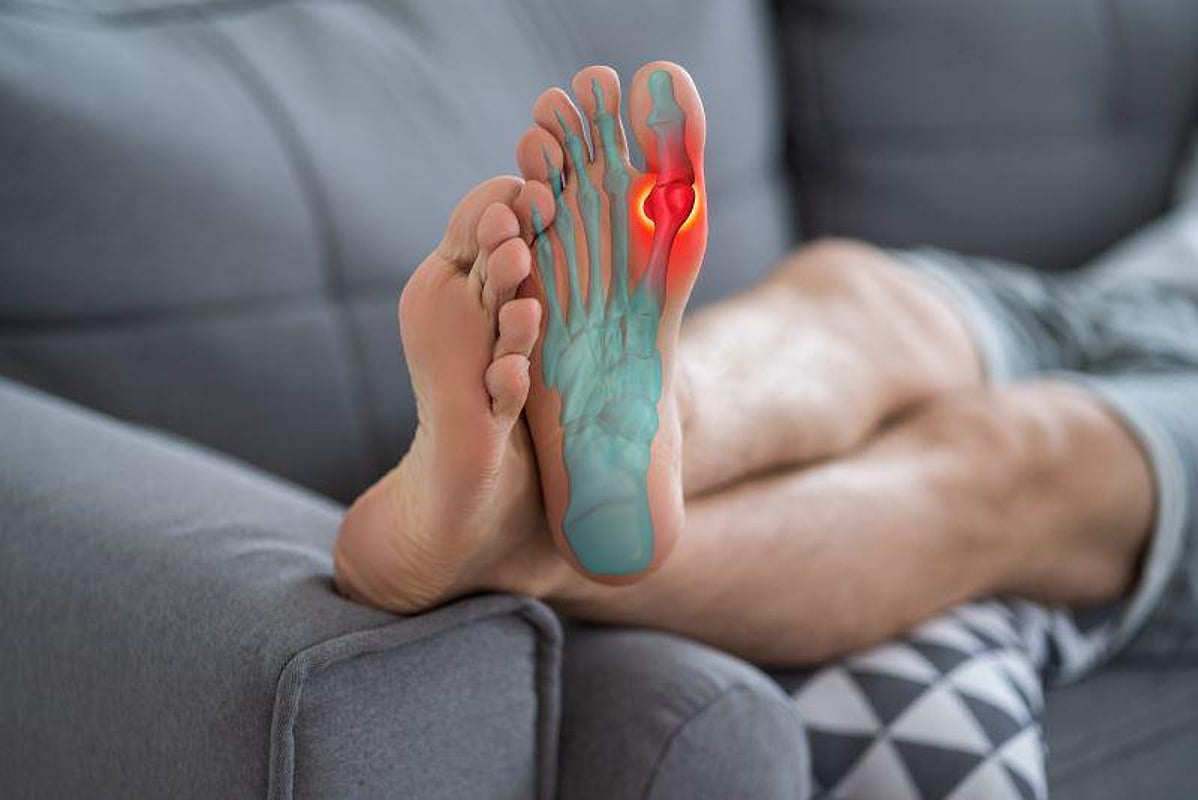Immediate Gout Pain Relief: Medications & Self-Care Tips

Gout pain may be severe and oftentimes it strikes at night, so when it flares, you want fast relief.
Learn more about immediate pain relief for gout, including what medications and self-care tips may help, plus what surgery options may be available if the pain doesn’t go away.
What is gout pain?
Gout pain, part of an “acute attack” as described by the American Academy of Orthopaedic Surgeons (AAOS), is sudden and severe. You may feel the bad pain in both your small and big joints such as your:
- Ankle
- Big toe
- Finger
- Knee
- Shoulder
In the United States, 8.3 million adults are living with gout, according to Arthritis by the Numbers, a book of facts and figures from the Arthritis Foundation.
Gout pain causes
The pain is caused by microscopic crystals made of a substance in your body called uric acid.
The body makes uric acid when it breaks down purines, which are found in your body and the foods you eat, according to the U.S. Centers for Disease Control and Prevention (CDC).
When there's too much uric acid, crystals can build up in joints, fluids and tissues in the body, the CDC says.
“These tiny crystals are like grains of sand in the joints, preventing smooth range of motion and causing pain and inflammation,” the AAOS said.
The only good news is that gout attacks don’t happen daily. Years can pass between attacks. But, sometimes it’s only months.
Gout pain symptoms
Gout pain in your foot and other areas can come with other symptoms that mimic an infection, according to the AAOS.
“Your body reacts to uric acid crystals as if they were a foreign body or bacteria," it explained. "White blood cells and other infection-fighting cells are sent into the area, which results in inflammation. This reaction can look just like an infection.”
Symptoms that mimic those of an infection include:
- Heat
- Redness
- Swelling (inflammation)
- Tenderness
Immediate gout pain relief
When you need to stop gout pain, look to medications and self-care.
Medications
For quick relief from pain, reach for NSAIDs (nonsteroidal anti-inflammatory drugs). These three painkilling options are oral medications:
- Aspirin
- Ibuprofen
- Naproxen sodium
Dr. Stuart Weisman, a rheumatologist at Boulder Community Health in Colorado, recommends his patients take the maximum dose of NSAIDs.
You can also try acetaminophen if your pain is not too severe. Follow dosing recommendations on the bottle.
Your doctor may also prescribe an anti-inflammatory medication to help with gout pain. These include:
- Corticosteroids: You can take these by mouth or get a shot.
- Colchicine: This medication can help with acute attacks and may also stop future attacks.
Weisman recommends asking for a 14-day course if you doctor prescribes corticosteroids. That makes sure you’ll have enough medicine if the attack persists. Finally, Weisman recommended that if you’re going to take colchicine, take it right away, when the attack starts.
"All of these options have possible side effects,” Weisman said. “None should be taken without checking with your doctor first."
Self-care tips
Self-care starts with a healthy lifestyle, as outlined by the Arthritis Foundation. Eat well, maintain a healthy weight and work on physical activity. Those goals may help your gout in general, so try these ideas if you need fast pain relief:
- Put ice on your painful joints. If you don’t have an ice pack, crush some ice in a plastic bag or grab a bag of peas from your freezer.
- Use assistive devices like a cane or a walker. These can help you walk when you’re in pain.
- Get rid of anything that puts pressure on your big toe. That extra weight, even from a bed sheet, can cause you pain. Don’t wear a shoe on that foot. If you’re wearing socks, cut a hole for your big toe. And when you sleep, use something to keep the sheets and blankets off.
- Put your foot up. Get your painful foot higher than your chest by stacking pillows underneath.
Gout pain surgery
Gout can cause a lot of damage and gout pain doesn’t always go away with medications and self-care. If you can’t get relief, the Arthritis Foundation explains, you may need surgery:
- Tophi removal: A tophus is the swollen bulbous growth that develops when uric acid crystals build up around your joints. This procedure gets rid of these tophi (plural) so they don’t cause any more problems.
- Arthroscopic uric acid crystal removal: The name of this procedure also describes what it does. Uric acid crystals can get in your joints.
- Joint fusion: This surgery replaces damaged joint cartilage in your hands with plates and screws. You won’t be able to move your hands like you used to, but you won’t have the pain.
- Joint replacement: The surgeon replaces your damaged joint with a prosthetic, or artificial, joint.
Living with gout pain
If you’re living with gout, you’re also living with the threat of an attack of pain that could happen at any time. With medications and self-care tips at your side, that attack may be far more bearable.
References
Stuart Weisman, MD, rheumatologist, Boulder Community Health, Boulder, Colo.
American Academy of Orthopaedic Surgeons (AAOS): Gout
Arthritis Foundation: Arthritis by the Numbers
Arthritis Foundation: Treatment for Gout
Medline Plus: Gout
U.S. Centers for Disease Control and Prevention (CDC): Gout
Related Posts
Lead Exposure Poses Considerable Global Health, Economic Burden
TUESDAY, Sept. 12, 2023 (HealthDay News) -- Global lead exposure has...
Indigenous Children Continue to Experience High Rates of RSV
FRIDAY, July 14, 2023 (HealthDay News) -- American Indian/Alaska Native (AI/AN)...
HPV-Associated Cancer Incidence Starting to Increase
FRIDAY, March 11, 2022 (HealthDay News) -- The incidence of human papillomavirus...
U.S. Nursing Home Deaths Rise as Delta Spreads
MONDAY, Oct. 4, 2021 (HealthDay News) -- There has been a significant increase...
